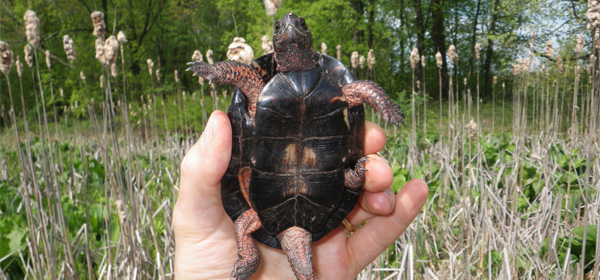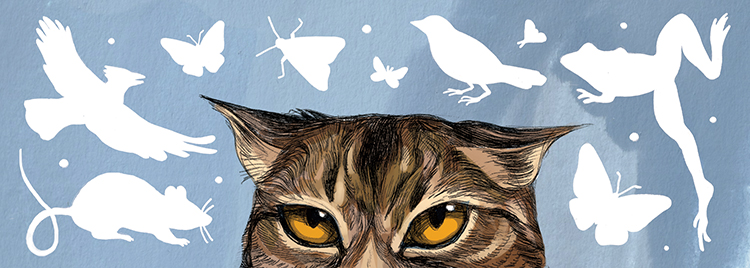 Story and photo by Bernard Brown“You’re too cute to hate,” I told the hockey puck-sized black turtle as it clawed at me to get down and craned its neck to bite my hand. Biting is cute when the critter is round, helpless and has big, black eyes. Unfortunately, cute doesn’t count for much when you’re holding up development. The bog turtle (classified under the Endangered Species Act as “threatened”), like the desert tortoise in Southern California, is one of those species that gets in the way. If you’re a retiring farmer looking to cash out by selling your land to a developer, a little turtle hiding in marshy, overgrown fields seems like a ridiculous obstacle.
Story and photo by Bernard Brown“You’re too cute to hate,” I told the hockey puck-sized black turtle as it clawed at me to get down and craned its neck to bite my hand. Biting is cute when the critter is round, helpless and has big, black eyes. Unfortunately, cute doesn’t count for much when you’re holding up development. The bog turtle (classified under the Endangered Species Act as “threatened”), like the desert tortoise in Southern California, is one of those species that gets in the way. If you’re a retiring farmer looking to cash out by selling your land to a developer, a little turtle hiding in marshy, overgrown fields seems like a ridiculous obstacle.
I side with the turtle. True, I’m an urbanite who doesn’t see the need for suburbs. I’m also a reptile and amphibian fanatic who loves hacking through briars and yanking my boots out of sucking mud to spend quality time with turtles. I’ve long hoped to find a bog turtle on my own. Unfortunately, they’re so rare and their habitat so secret (I was sworn to be no more specific than “Southeast Pennsylvania” for this trip), I long ago gave up any real hope of it happening. Getting invited by the Nature Conservancy to see (measure, photograph, document) real, live bog turtles was a little like an Eagles fan finding himself alone at a bar with a suddenly chatty Andy Reid: This must be a dream.
In another 50 years, it might be little more than a fond memory. The Endangered Species Act (ESA) and entities (state, local and federal governments, plus nonprofit groups like the Nature Conservancy) fighting for bog turtles face a hard slog. The ESA is pretty good at reducing trade in endangered species—indeed, though poaching is still a problem, the federal protection has helped reduce bog turtle collection for the pet trade—but the bog turtle’s bigger problem is habitat destruction and fragmentation. As far as I can tell, it is very difficult to create new bog turtle habitat, making it crucial to protect and enhance current habitat.
For centuries, their wet meadows have been in high demand for agriculture. Bog turtles can get along with cattle (indeed, the Nature Conservancy grazes cattle on the property we visited to keep the marsh open), but not so much with fields ditched and drained for crops. These days, subdivisions and office parks are driving out both the farmers and the turtles. Roads and houses separate wetlands, leaving isolated turtle populations vulnerable to local extinction. Perhaps more importantly, bog turtles rely on a dynamism that is impossible in our carved-up, static landscapes. A pre-settlement Delaware Valley stream corridor was a shifting series of woods, beaver ponds that drowned the trees, and old ponds morphing into marshes and wet meadows. One marsh might disappear, but another would develop just downstream. Housing subdivisions don’t develop into anything else.
The Nature Conservancy Land Steward George Gress and I found five bog turtles basking that day. One was an old survivor, her shell burnished by years of burrowing, missing one foot completely and a couple toes on another. The records showed her to be at least in her 40s; she was hanging out with a male they hadn’t seen before. He chomped on George’s finger while getting marked. I’m proud to say I found one turtle myself, though not as proud to say I found her by stepping on her (stealthy little buggers). She was okay; these are tough little turtles that can take being pushed into the weeds and mud, but only if they have weeds and mud to live in.
Bernard Brown is an amateur field herper, part-time bureaucrat and director of the PB&J Campaign (pbjcampaign.org), a movement focused on the benefits of eating lower on the food chain. Read about his forays into the natural world at phillyherping.blogspot.com. Be sure to pick up next month’s issue to read about invasive reeds.
For more on the Nature Conservancy, including a state-by-state list of initiatives, visit nature.org.



